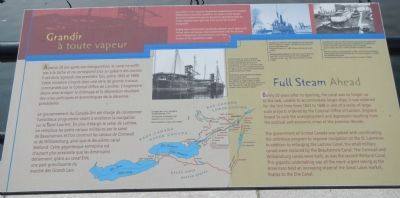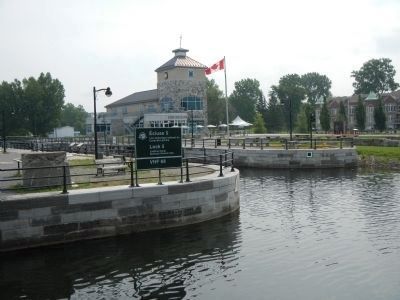Lachine in Montréal in Communauté-Urbaine-de-Montréal, Québec — Central Canada (French-Canadian)
Full Steam Ahead
Grandir à toute vapeur

Photographed By Barry Swackhamer, August 5, 2014
1. Full Steam Ahead Marker
Click on the image to enlarge the map.
Captions (English / French): (map) The network of Canadian and American canals in 1848. / Le réseau de canaux canadiens et américains en 1848.; (top, middle) Sailing ships and steamers gradually replaced small, open craft. Sailing ships and barges clearly dominated until the second enlargement, accounting for over three-fourths of the registered vessels. / Les voiliers et les vapeurs remplacent graduellement les petites embarcations ouvertes. Toutefois. les voiliers et les barges dominent nettement jusqu’au deuxième agrandissement du canal, comptant pour plus des trois quarts des navires enregistrés.; (center, middle) The schooner was a wooden ship topped by two or three masts. It was hauled in the canals towed by a steamer on wider bodies of water. / Le schooner est un sorte de goélette en bois, surmontée de deux ou trois mâts. Ce navire et hâlé dans les canaux et remorqué par un vapeur sur les plans d’eau.; (top left) Paddlewheelers appeared on the river around 1810, but they didn’t use the canal until its first enlargement. / Les vapeurs à aubes font leur apparition sur le fleuve vers 1810. Toutefois, ils n’emprunteront canal qu’après son premier agrandissement.; With the invention of the propeller in 1841, more functional steamers could be built. particularly because the aft-mounted engines increased the available cargo space. . L’invention d l’hélice en 1841 permet la construction de vapeurs plus fonctionnels, notamment parce que l’installation de la machinerie à l’arrière l’espace disponible pour la cargaison.
Captions (English / French): (map) The network of Canadian and American canals in 1848. / Le réseau de canaux canadiens et américains en 1848.; (top, middle) Sailing ships and steamers gradually replaced small, open craft. Sailing ships and barges clearly dominated until the second enlargement, accounting for over three-fourths of the registered vessels. / Les voiliers et les vapeurs remplacent graduellement les petites embarcations ouvertes. Toutefois. les voiliers et les barges dominent nettement jusqu’au deuxième agrandissement du canal, comptant pour plus des trois quarts des navires enregistrés.; (center, middle) The schooner was a wooden ship topped by two or three masts. It was hauled in the canals towed by a steamer on wider bodies of water. / Le schooner est un sorte de goélette en bois, surmontée de deux ou trois mâts. Ce navire et hâlé dans les canaux et remorqué par un vapeur sur les plans d’eau.; (top left) Paddlewheelers appeared on the river around 1810, but they didn’t use the canal until its first enlargement. / Les vapeurs à aubes font leur apparition sur le fleuve vers 1810. Toutefois, ils n’emprunteront canal qu’après son premier agrandissement.; With the invention of the propeller in 1841, more functional steamers could be built. particularly because the aft-mounted engines increased the available cargo space. . L’invention d l’hélice en 1841 permet la construction de vapeurs plus fonctionnels, notamment parce que l’installation de la machinerie à l’arrière l’espace disponible pour la cargaison.
Barely 20 years after its opening, the canal was no longer up to the task, unable to accommodate larger ships. It was widened for the first time in 1843 to 1848 in one of a series of large-scale projects ordered by the Colonial Office of London. England hoped to curb the unemployment and depression resulting from the political and economic crises of the previous decade.
The government of United Canada was tasked with coordinating the ambitious program to improve navigation on the St. Lawrence. In addition to enlarging the Lachine Canal, the small military canals were replaced by the Beauharnois Canal. The Cornwall and Williamsburg canals were built, as was the second Welland Canal. This gigantic undertaking was all the more urgent seeing as the Americans held an increasing share of the Great Lakes market, thanks to the Erie Canal.
French:
À peine 20 ans après son inauguration, le canal ne suffit pas à la tâche en ne correspond plus au gabarit des navires. Il es donc agrandi une première fois, entre 1843 et 1848. Cette initiative s’inscrit dans une série des grands travaux commandes par le Colonial Office de Londres. L’Angleterre désire ainsi enrayer le chômage et la dépression résultant des crises politique et économiques de la décennie précédent.
Le gouvernement du Canada-Uni est chargé de coordonner l’ambitieux programme visant à améliorer la navigation sur le Saint-Laurent. En plus d’élargir le canal de Lachine, on remplace les petits canaux militaries par le canal de Beauharnois et l’on construit les canaux de Cornwall et de Williamsburg. Cette gigantesque enterprise est d’autant plus pressant que les Américains deviennent, grâce au canal Érié, une part grandissant du marché des Grands Lacs.
Erected by Parks Canada / Parcs Canada.
Topics. This historical marker is listed in this topic list: Waterways & Vessels. A significant historical year for this entry is 1843.
Location. 45° 25.866′ N, 73° 40.136′ W. Marker is in Montréal, Québec, in Communauté-Urbaine-de-Montréal. It is in Lachine. Marker is on Boulevard Saint-Joseph near Chemin du Musée, on the left when traveling east. Touch for map. Marker is at or near this postal address: 600 Boulevard Saint-Joseph, Montréal QC H8S 2M1, Canada. Touch for directions.
Other nearby markers. At least 8 other markers are within walking distance of this marker. Growing With the Times (here, next to this marker); An Upstream Battle (within shouting distance of this marker); A Wonderful New Addition (within shouting distance of this marker); The Lachine Canal (about 120 meters away, measured in a direct line); Frances Anne Hopkins (approx. half a kilometer away); The Hudson's Bay Company in Lachine
(approx. half a kilometer away); Lachine: Gateway to the Northwest (approx. half a kilometer away); Lachine Massacre (approx. half a kilometer away). Touch for a list and map of all markers in Montréal.
More about this marker. This marker is across the canal from the Lachine Canal Visitors Center.
Credits. This page was last revised on February 9, 2023. It was originally submitted on April 5, 2015, by Barry Swackhamer of Brentwood, California. This page has been viewed 326 times since then and 6 times this year. Photos: 1, 2. submitted on April 5, 2015, by Barry Swackhamer of Brentwood, California. • Andrew Ruppenstein was the editor who published this page.
